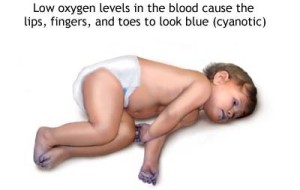
Cyanosis is the condition where the skin turns to a blue or purple hue.The red blood cells bring oxygen to the different body tissues and in return, take up the carbon dioxide and other wastes to be expelled from the body. It usually begins in the lips, tongue or fingernails, and most visible in the same areas. It is usually indicative of decreased oxygen in the bloodstream. It may denote an underlying lung illness but it may also connote of a heart or major blood vessel defect.
When oxygen levels drop by only a small amount, cyanosis may be hard to detect, especially in dark-skinned people. For dark-skinned people, it may be easier to detect cyanosis in the lips, gums, around the eyes and other mucus membranes.
Cyanosis Types
There are two types of cyanosis, differentiated according to their different affected area.
- Central cyanosis
- Cyanosis on the central parts of the body, such as the head, torso, lips and mouth
- Decreased oxygen in blood
- Due to cardiac, respiratory or blood illnesses
- May also be accompanies by acrocyanosis
- Acrocyanosis
- Cyanosis in the extremities, specifically the fingertips, palms of the hand and the soles of the feet
- Often normal in babies, if not supplemented by central cyanosis
Cyanosis Causes
Certain problems can arise to cyanosis. These include:
- Only one part of the body
- Blood clots that block blood supply to limbs
- Raynaud’s Phenomenon
- Heart problems
- Congenital heart defects
- Heart failure
- Cardiac arrest
- Lung problems
- Pulmonary embolism
- Bronchiolitis
- Asthma
- Chronic obstructive pulmonary disease
- Drowning or near drowning
- Severe pneumonia
- High altitudes
- Airways leading to lungs problems
- Holding of breath
- Choking
- Long-lasting seizures
- Croup
- Epiglottis
- Others
- Drug overdose
- Ingestion of toxins
- Exposure to cold air or water
Cyanosis Symptoms
Depending on the underlying cause, cyanosis may develop abruptly, 
- Fainting
- Lethargy
- Fatigue
- Trouble breathing
- Thickening of tissues beneath the nails
- The following serious symptoms may denote a serious condition
- Difficulty breathing
- Chest pain or angina
- Loss of consciousness
Cyanosis Treatment
As is with every common symptom, cyanosis is treated according to its underlying cause. Some of the treatments for cyanosis are the following:
- Oxygen therapy
- Warming of affected areas
- Surgery
- Intravenous (IV) fluids
- Drug treatment
As a symptom, cyanosis can denote serious life-threatening conditions which have to be treated immediately. Understanding cyanosis can help when taking first aid courses, especially in topics related to respiratory or blood flow conditions.
i am a patient of central cyanosis i have found this information helpful to manage my condition. the underlying problem is my lung ,i produce o lot of sputum at least 240ml a day and i am ever on o2
My brother has blue circles around his eyes when he lies down flat. It goes away when he sits up. He has underlying heart conditions. Is this something we should be concerned about?